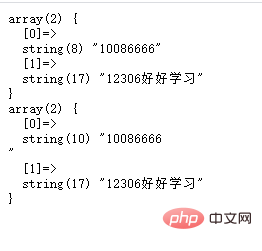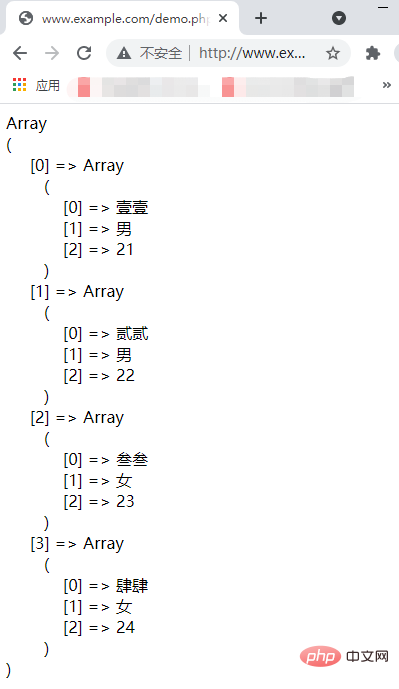Usage of mysqli_select_db and mysqli_query functions in PHP
In the previous article, I brought you "How to connect to the MySQL database in PHP? ", which introduces in detail how to connect to the MySQL database in PHP. In this article, we take a look at the relevant knowledge of PHP using the mysqli_select_db() function to select a database. I hope everyone has to help!

As mentioned in the previous article, PHP can connect to the MySQL database through the mysqli_connect() function. One parameter of this function is the name of the corresponding database. , this parameter is an optional parameter and can be omitted. If you omit this parameter, you need to specify a default database later. In PHP, you can specify a default database through the mysqli_select_db() function. Then let’s take a look at the usage of this function.
<strong><span style="font-size: 20px;">mysqli_select_db()</span></strong>Function
The syntax of this function The format is also divided into two situations. One is the object-oriented writing method, and its syntax format is as follows:
mysqli::select_db(string $dbname)
where $dbname represents the specified database name, and the other The first is a process-oriented writing method, and its syntax format is as follows:
mysqli_select_db(mysqli $link, string $dbname)
It should be noted that:
$dbnameis still expressed as specified Database name,$linkrepresents the database connection returned by the mysqli_connect() function.
If the function is successfully executed, the return result is true. If the function fails, the return result is false.
Next, let’s take an example to see how to select a database through the mysqli_select_db() function. The example is as follows:
<?php
$host = 'localhost';
$username = 'root';
$password = 'root';
$dbname = 'test';
$mysql = new Mysqli($host, $username, $password);
if($mysql -> connect_errno){
die('数据库连接失败:'.$mysql->connect_errno);
}else{
$mysql -> select_db($dbname); // 选择名为 test 的数据库
$sql = 'select name,sex,age from user'; // SQL 语句
$result = $mysql -> query($sql); // 执行上面的 SQL 语句
$data = $result -> fetch_all();
$mysql -> close();
}
echo '<pre class="brush:php;toolbar:false">';
print_r($data);
?>The above example selects a database named “test” through the mysqli_select_db() function. ” database, the output results are as follows:

The above example uses object-oriented writing. Next, let’s take a look at what process-oriented writing looks like. Example As follows:
<?php
$host = 'localhost';
$username = 'root';
$password = 'root';
$dbname = 'test';
$link = @mysqli_connect($host, $username, $password);
if($link){
mysqli_select_db($link, $dbname); // 选择名为 test 的数据库
$sql = 'select name,sex,age from user'; // SQL 语句
$result = mysqli_query($link, $sql); // 执行 SQL 语句,并返回结果
$data = mysqli_fetch_all($result); // 从结果集中获取所有数据
mysqli_close($link);
}else{
echo '数据库连接失败!';
}
echo '<pre class="brush:php;toolbar:false">';
print_r($data);
?>In the above example, the difference between the two writing methods is not big, and the output results are the same. From this we specify a default database through the mysqli_select_db() function. Then let's take a look at the mysqli_query() function. What does it do and how is it used?
<strong><span style="font-size: 20px;">mysqli_query()</span></strong>## Function
mysqli_query() function. The syntax format of this function is as follows:
mysqli::query( string $query [, int $resultmode = MYSQLI_STORE_RESULT ] )
$query
represents the SQL statement to be executed;$resultmode
is an optional parameter, used to modify the behavior of the function.
mysqli_query( mysqli $link , string $query [, int $resultmode = MYSQLI_STORE_RESULT ] )
$link
Represents the database connection returned by the mysqli_connect() function;$query
Represents the SQL statement to be executed;$resultmode
is an optional parameter used to modify the behavior of the function.
mysql> select * from user;First of all, let’s take a look at the object-oriented writing method. The example is as follows :---- -------- ------ ------
| id | name | age | sex |
---- -------- ------ ------
| 1 | 一一 | 21 | Male |
| 2 | 二二 | 22 | Male |
| 3 | Sansan | 23 | Female |
| 4 | Four Four | 24 | Female |
---- --- ----- ------ ------
4 rows in set (0.00 sec)
<?php
$host = 'localhost';
$username = 'root';
$password = 'root';
$dbname = 'test';
$mysql = new Mysqli($host, $username, $password, $dbname);
if($mysql -> connect_errno){
die('数据库连接失败:'.$mysql->connect_errno);
}else{
$mysql -> set_charset('UTF-8'); // 设置数据库字符集
$sql = 'select name,sex,age from user'; // SQL 语句
$result = $mysql -> query($sql); // 执行上面的 SQL 语句
$data = $result -> fetch_all();
$mysql -> close();
}
echo '<pre class="brush:php;toolbar:false">';
print_r($data);
?>
<?php
$host = 'localhost';
$username = 'root';
$password = 'root';
$dbname = 'test';
$link = @mysqli_connect($host, $username, $password, $dbname);
if($link){
$sql = 'select name,sex,age from user'; // SQL 语句
$result = mysqli_query($link, $sql); // 执行 SQL 语句,并返回结果
$data = mysqli_fetch_all($result); // 从结果集中获取所有数据
mysqli_close($link);
}else{
echo '数据库连接失败!';
}
echo '<pre class="brush:php;toolbar:false">';
print_r($data);
?>If you are interested, you can click on "PHP Video Tutorial" to learn more about PHP knowledge.
The above is the detailed content of Usage of mysqli_select_db and mysqli_query functions in PHP. For more information, please follow other related articles on the PHP Chinese website!

Hot AI Tools

Undresser.AI Undress
AI-powered app for creating realistic nude photos

AI Clothes Remover
Online AI tool for removing clothes from photos.

Undress AI Tool
Undress images for free

Clothoff.io
AI clothes remover

Video Face Swap
Swap faces in any video effortlessly with our completely free AI face swap tool!

Hot Article

Hot Tools

Notepad++7.3.1
Easy-to-use and free code editor

SublimeText3 Chinese version
Chinese version, very easy to use

Zend Studio 13.0.1
Powerful PHP integrated development environment

Dreamweaver CS6
Visual web development tools

SublimeText3 Mac version
God-level code editing software (SublimeText3)

Hot Topics
 1392
1392
 52
52
 36
36
 110
110
 PHP and Python: Comparing Two Popular Programming Languages
Apr 14, 2025 am 12:13 AM
PHP and Python: Comparing Two Popular Programming Languages
Apr 14, 2025 am 12:13 AM
PHP and Python each have their own advantages, and choose according to project requirements. 1.PHP is suitable for web development, especially for rapid development and maintenance of websites. 2. Python is suitable for data science, machine learning and artificial intelligence, with concise syntax and suitable for beginners.
 PHP's Current Status: A Look at Web Development Trends
Apr 13, 2025 am 12:20 AM
PHP's Current Status: A Look at Web Development Trends
Apr 13, 2025 am 12:20 AM
PHP remains important in modern web development, especially in content management and e-commerce platforms. 1) PHP has a rich ecosystem and strong framework support, such as Laravel and Symfony. 2) Performance optimization can be achieved through OPcache and Nginx. 3) PHP8.0 introduces JIT compiler to improve performance. 4) Cloud-native applications are deployed through Docker and Kubernetes to improve flexibility and scalability.
 PHP: A Key Language for Web Development
Apr 13, 2025 am 12:08 AM
PHP: A Key Language for Web Development
Apr 13, 2025 am 12:08 AM
PHP is a scripting language widely used on the server side, especially suitable for web development. 1.PHP can embed HTML, process HTTP requests and responses, and supports a variety of databases. 2.PHP is used to generate dynamic web content, process form data, access databases, etc., with strong community support and open source resources. 3. PHP is an interpreted language, and the execution process includes lexical analysis, grammatical analysis, compilation and execution. 4.PHP can be combined with MySQL for advanced applications such as user registration systems. 5. When debugging PHP, you can use functions such as error_reporting() and var_dump(). 6. Optimize PHP code to use caching mechanisms, optimize database queries and use built-in functions. 7
 PHP vs. Other Languages: A Comparison
Apr 13, 2025 am 12:19 AM
PHP vs. Other Languages: A Comparison
Apr 13, 2025 am 12:19 AM
PHP is suitable for web development, especially in rapid development and processing dynamic content, but is not good at data science and enterprise-level applications. Compared with Python, PHP has more advantages in web development, but is not as good as Python in the field of data science; compared with Java, PHP performs worse in enterprise-level applications, but is more flexible in web development; compared with JavaScript, PHP is more concise in back-end development, but is not as good as JavaScript in front-end development.
 MySQL's Place: Databases and Programming
Apr 13, 2025 am 12:18 AM
MySQL's Place: Databases and Programming
Apr 13, 2025 am 12:18 AM
MySQL's position in databases and programming is very important. It is an open source relational database management system that is widely used in various application scenarios. 1) MySQL provides efficient data storage, organization and retrieval functions, supporting Web, mobile and enterprise-level systems. 2) It uses a client-server architecture, supports multiple storage engines and index optimization. 3) Basic usages include creating tables and inserting data, and advanced usages involve multi-table JOINs and complex queries. 4) Frequently asked questions such as SQL syntax errors and performance issues can be debugged through the EXPLAIN command and slow query log. 5) Performance optimization methods include rational use of indexes, optimized query and use of caches. Best practices include using transactions and PreparedStatemen
 The Enduring Relevance of PHP: Is It Still Alive?
Apr 14, 2025 am 12:12 AM
The Enduring Relevance of PHP: Is It Still Alive?
Apr 14, 2025 am 12:12 AM
PHP is still dynamic and still occupies an important position in the field of modern programming. 1) PHP's simplicity and powerful community support make it widely used in web development; 2) Its flexibility and stability make it outstanding in handling web forms, database operations and file processing; 3) PHP is constantly evolving and optimizing, suitable for beginners and experienced developers.
 PHP vs. Python: Core Features and Functionality
Apr 13, 2025 am 12:16 AM
PHP vs. Python: Core Features and Functionality
Apr 13, 2025 am 12:16 AM
PHP and Python each have their own advantages and are suitable for different scenarios. 1.PHP is suitable for web development and provides built-in web servers and rich function libraries. 2. Python is suitable for data science and machine learning, with concise syntax and a powerful standard library. When choosing, it should be decided based on project requirements.
 PHP's Purpose: Building Dynamic Websites
Apr 15, 2025 am 12:18 AM
PHP's Purpose: Building Dynamic Websites
Apr 15, 2025 am 12:18 AM
PHP is used to build dynamic websites, and its core functions include: 1. Generate dynamic content and generate web pages in real time by connecting with the database; 2. Process user interaction and form submissions, verify inputs and respond to operations; 3. Manage sessions and user authentication to provide a personalized experience; 4. Optimize performance and follow best practices to improve website efficiency and security.




